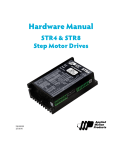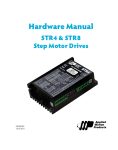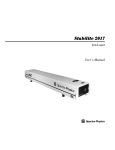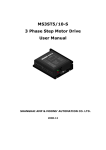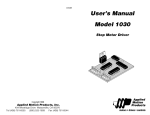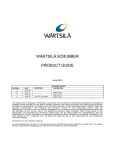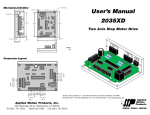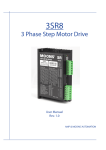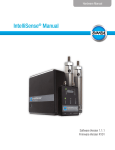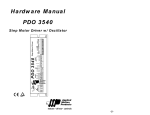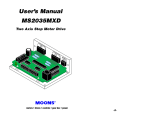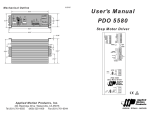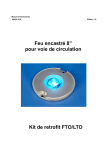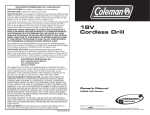Download OLE/manuals
Transcript
Original Line Electric Actuator, Electric Thruster, Motor, and Driver Quick Start Manual Please read this manual carefully before implementing your Original Line Electric or Electric Thruster Actuator Scope of this manual This instruction manual supports Bimba standard components only. If special motion control components, including but not limited to power supplies, encoders, motors, controls, and drivers, are included based on a customer’s specifications or special request, it is the customer’s responsibility to consult support materials and technical support specific to these special components provided by the third party manufacturers. Bimba assumes no liability for misuse, misapplication, or support for components that are not the Bimba brand. Original Line Electric Actuator, Electric Thruster, Motor, and Driver Quick Start Manual Contents 1. Actuator-only Models ...................................................................... 2 Installing your motor 2. Actuator and Motor Models ............................................................ 4 Motor specifications and wiring diagram 3. Actuator, Motor, and Driver Models ................................................ 6 a. Mount your drive ...................................................................... 6 b. Connect the DC power supply to the driver ............................. 7 c. Connect the motor to the driver ............................................... 7 d. Set rotary switch for motor selected ........................................ 8 e. Adjust running and idle current ................................................ 8 f. Set load inertia ........................................................................ 9 g. Select step resolution .............................................................. 9 h. Apply power and run self test ................................................ 10 i. Connect input signals ............................................................ 10. j. FAULT output ......................................................................... 13 k. Set step pulse type ................................................................ 14 l. Step pulse noise filter ............................................................ 14 m.Technical specifications ......................................................... 15 n. Alarm codes .......................................................................... 16 Troubleshooting Guide and FAQ ...................................................... 17 1 Congratulations on purchasing an Original Line Electric actuator from Bimba. Our OLE and OLET actuators are designed, built, and tested to provide the longest life, greatest durability, highest speed, and greatest thrust per dollar. We look forward to serving your electric actuator needs with the same responsiveness and engineering expertise you are accustomed to receiving for our pneumatic products. Every OLE and OLET actuator is backed by a one-year warranty. Extend it to a two-year warranty by registering on our website at www.bimba.com/pdf/OLEwarrantyregistration.pdf. 1. Actuator-only Models Installing your motor a. Remove plug to provide access to coupler. Use a 1/8 inch allen key. b. Turn the actuator coupler so the clamp screw is aligned with the access hole. Loosen coupler setscrew using allen key. Allen key sizes are identified in Table 1. ! Only loosen the clamp screw until it no longer secures the motor shaft. Loosening it too much may result in the screw falling out of the coupler, or binding against the actuator’s inside wall. Table 1 Allen Key 5/64" 3/32" 3/32" Note: Torque range is ± 10%. Actuator 75 150 350 Torque 3.8 in-lbs. 8 in-ibs. 8 in-lbs. 2 c. Mount motor to actuator, slip shaft into coupler. Secure motor to actuator using 4 screws provided. Allen key sizes and torque values are provided in Table 2. Be careful not to turn the coupler. Table 2 Allen Key 9/64" 9/64" 5/32" Note: Torque range is ± 10%. Actuator 75 150 350 Torque 12 in-lbs. 12 in-lbs. 35 in-lbs. d. Tighten coupler clamp screw so motor shaft is secured (refer to Table 1 for torque specification). The coupler clamps around the circumference of the motor shaft. The orientation of any flat (or key- way) on the shaft does not matter. ! Tighten the coupler clamp screw to the torque value in Table 1. e. Replace the coupler access plug. ! DO NOT screw the plug in to a hard stop. Only screw it in far enough so that the top of the plug is flush with the outside surface of the actuator. 3 $ 2. Actuator and Motor Models Orange All Bimba step Org/Wht motors use the same 6HULHV 8-wire wiring color code convention, as Blk/Wht shown below. . $² Black Red Red/ Wht % ! Yel/ Wht $ Blk/Wht Org/ Wht $² Yellow %² Orange 3DUDOOHO Black Red Yel/ % Wht Figure 1 Yellow Red/Wht %² Warning: Be sure power is off before connecting or disconnecting the motor. Specifications for Bimba 8-lead 1.8 degree step motors are provided in Table 3. Winding Min. Holding Frame Connection Torque (oz-in) Parallel 62.3 Series 62.3 17 Unipolar 43.9 Parallel 177 23 Series 177 Unipolar 125 Parallel 269.1 23 Series 269.1 Unipolar 191.2 Parallel 1260 34 Series 1260 Unipolar 906 Table 3 Volts 2.9 5.6 4.0 2.1 4.2 3.0 2.1 4.2 3.0 2.72 5.43 3.88 Amps Ohms 1.7 0.85 1.2 4.2 2.1 3.0 4.2 2.1 3.0 5.6 2.8 4.0 1.7 6.6 3.3 0.37 1.5 0.75 0.5 2.0 1.0 0.48 1.94 0.97 mH 2.5 10.0 2.5 1.2 4.8 1.2 1.7 6.8 1.7 5.4 21.6 5.4 Rotor Inertia (oz-in2/g-cm2) 0.44/82 0.44/82 0.44/82 1.64/300 1.64/300 1.64/300 2.51/460 2.51/460 2.51/460 15.0/2750 15.0/2750 15.0/2750 If you have ordered your actuator with a motor/encoder combination, the encoder specifications are listed in Table 4. Table 4 Incremental Encoder Specifications Power Input 5 V DC, 160 mA Resolution 2000 pulses per rev. Output High 2.5 V DC Min. Output Low 0.5 V DC Max. Operating Frequency 500 kHz Max. Operating Temperature -30 to 115°C Enclosure Rating IP40 4 Encoder connections for Bimba step motors are identified in Table 5. The cable provided has flying leads which can be connected to your controller. Pin No. 1 2 3 4 5 6 7 8 9 10 11 12 13 14 15 Table 5 Wire Color Yellow Yellow/White Blue Blue/White Orange Orange/White Green Green/White Brown Brown/White White Gray/White Red Black Gray 5 Function Channel A Channel AChannel B Channel BIndex Index- Not used +5 V DC input power Encoder ground Drain/shield 3. Actuator, Motor, and Driver Models You will need: • An OLE or OLET actuator with motor attached. • A small flat blade screwdriver for tightening the connectors. • Wires - 18 to 20 gage recommended • Wire cutter/stripper • An appropriate DC power supply. ! Warning: Do not apply power until all connections are made. The DRV-4 accepts power supply voltages from 24 to 48 VDC, while the DRV-8 accepts power supply voltages from 24 to 75 VDC. The current demand will never exceed double the motor current (see Table 3, Amps column). However, the DRV will convert a high voltage low current power supply into a lower voltage higher current power supply. A 24V 4A supply will perform similarly to a 48V 2A supply. Use Table 7 below as a guideline. ! Use unregulated power supplies without overvoltage protection to avoid problems with regeneration during rapid deceleration. OLE Drive -75 -75 -150 -350 DRV-4 DRV-4 DRV-8 DRV-8 Power Supply Voltage 24-48 24-48 24-75 24-75 Bimba Motor 17 frame 23 frame 23 frame 34 frame Table 7 Parallel Parallel 24V Power 48V Power Max Current Current Supply Supply Amps per Draw Draw Max. Amperage Amperage Phase 1.7 3.4 4 2 4.5 4.0 4.5 4 2 4.5 4.2 8.4 8 4 7.8 5.6 11.2 12 6 7.8 a. Mount your drive Motor & Power Supply Connector Mount the drive using #6 screws. Installing on a metal surface (recommended) helps dissipate heat. Forced air flow from a fan is also good practice. Run Current, Idle Current Steps/rev, Inertia, Self Test 6 Input & Output Signals Motor Selector Status LEDs ! Warnings: • Do not install drive where ambient air is more than 104° F. • Do not install drive where there is no air flow • Do not install drive where drive can get wet. • Do not install drive where electrically conductive material can fall on the driver. • Drives must be mounted at least one-half inch apart. b. Connect the DC power supply to the driver -- Do not apply power ! Warning: Observe proper polarity when connecting wires. I. Make sure the power supply is not on. Connect V+ and V- from the power supply to the V+ and V- terminals of your driver. II. Ensure a proper earth ground connection by using the screw on the left side of the chassis. All system components must be grounded to a single point common earth ground. If using an external fuse, we recommend the following in-line with the V+ connection: DRV-4: 3AG, 4 amp (Littlefuse 313004P) DRV-8: 3AG, 6.25 amp (Littlefuse 3136.25P) c. Connect the motor to the driver ! Warning: Never connect or disconnect the motor when power is applied. Connect OLE or OLET eight lead motors in parallel, as shown below. If using a motor from another source, please refer to your motor specs for wiring information. A motor wiring diagram is shown in Figure 1. A+ A- B+ B- ht /w ht w t + rg/ ht e wh g o an k+ l/w d/ or lac ye +re b ed+ ow r ell y k bl 7 d. Set rotary switch for the motor selected (This is normally set by the factory for the motor specified.) Turn the rotary switch to the number that represents the motor you have. This sets current and antiresonance settings for optimum performance. OLE -75 -75 -150 -350 Bimba Motor Frame 17 frame 23 frame 23 frame 34 frame Option Code Setting P1, E1, Y1, Z1 P2, E2, Y2, Z2 P2, E2, Y2, Z2 P3, E3, Y3, Z3 5 7 6 F e. Adjust running and idle current Switch 1 and 2 set the running current to 70%, 80%, 90% or 100% of the motor’s rated maximum current. Switch 4 sets the idle current to either 50% or 90% of the selected running current. Factory default is 90%. 1 2 1 2 1 2 1 2 4 4 100% 90% 80% 70% 50% 90% • Use 100% position in most applications (factory default) ! • Use lower settings for self locking threads (OLE 12, 16, and 20 leads). • Use lower settings to reduce motor temperature • Use higher settings for full holding torque • Use lower setting during initial setup to avert accidental damage • Use lower settings to address safety issues • Use lower settings to reduce motor temperature 8 f. Set load inertia Switch 3 chooses between two load inertia ranges. • Values are multiples of rotor inerta (see Table 3) • Use 0-4x for smaller (0.2" or smaller) leads and shorter strokes (factory default) • Use 5-10x for longer (0.25" or larger) leads and greater loads • 5-10x may reduce performance. This information is used in the anti-resonance configuration. 3 3 5-10X 0-4X g. Select step resolution There are 4 microstep resolutions to choose from as well as full and half step •200 •200µ (microstep emulation) factory default •400 5 6 7 5 6 7 5 6 7 5 6 7 20000 12800 5000 2000 5 6 7 5 6 7 5 6 7 5 6 7 400 µ SMOOTH 400 200 µ SMOOTH 200 •400µ (microstep emulation) •2000 •5000 •12800 •20000 The 200µ and 400µ settings use microstep emulation to provide smooth rotation at low speeds. Microstep emulation imparts a slight delay to the motion. If this is not acceptable, use the non-filtered 200 or 400 settings. 9 Microstepping provides smoothest rotation. However, a faster step pulse rate (frequency) is required for a given RPM as shown in Table 8 below. Pulses per Degrees per revolution step 200 1.8 400 0.9 2000 0.18 5000 0.072 12800 0.028 20000 0.018 Table 8 Pulse frequency required for 300 RPM 1,000 Hz 2,000 Hz 10,000 Hz 25,000 Hz 64,000 Hz 100,000 Hz Pulse frequency required for 3000 RPM 10,000 Hz 20,000 Hz 100,000 Hz 250,000 Hz 640,000 Hz 1,000,000 Hz h. Apply power and run self test The DRV-4 and DRV-8 have built in Self Test functions. When switch 8 is moved to the ON position, the drive will automatically rotate the motor back and forth, two turns in each direction. This feature can be used to confirm that the motor is correctly wired, selected and operational. Factory default is “OFF.” 8 8 ON OFF SELF TEST i. Connect input signals The drives have three inputs: • STEP: a high speed digital input for step pulse commands, 5-24 volt logic • DIR: a high speed digital input for the direction signal, 5-24 volt logic • EN: a 5-24V input for commanding the removal of power from the motor STEP and DIR inputs can be converted to STEP CW and STEP CCW by moving the internal jumper S3. For detailed instructions, go to Step “K” of this section. Refer to the illustration below for identification of step, direction, and enable inputs on the driver screw terminal blocks. FAULT– FAULT+ EN– EN+ DIR– DIR+ STEP– STEP+ Motor & Power Supply Connector Input & Output Signals inside drive Status LEDs STEP+ 220 pF STEPDIR+ 220 pF DIRRun Current, Idle Current Steps/rev, Inertia, Self Test Motor Selector 10 Connection Examples: STEP & DIR Indexer with Sourcing Outputs COM DIR- DIR DIR+ STEP- STEP DRV STR STEP+ Connecting to indexer with Sourcing Outputs Indexer with Sinking Outputs +5V OUT DIR+ DIR DIRSTEP+ STEP STR DRV STEP- Connecting to Indexer with Sinking Outputs Indexer with Differential Outputs DIR+ DIR+ DIR- DIR- STEP+ STEP+ STEP- STEP- STR DRV Connecting to Indexer with Differential Outputs (Many High Speed Indexers have Differential Outputs) 11 Connection Examples: EN The 5-24 V EN input disables power to the motor. 5-24 VDC Power Supply EN+ + STR DRV switch or relay (closed=logic low) - EN- Connecting an Input to a Switch or Relay Si drive EN+ OUT+ EN- 5-24 VDC Power Supply STR DRV DRIVE + - OUT– Connecting another drive to EN (When output closes, input closes) 12-24 VDC Power Supply + - + output NPN Proximity Sensor – EN+ EN- DRV STR Connecting an NPN Type Proximity Sensor to an input (When prox sensor activates, input closes) 12-24 VDC Power Supply + + output PNP Proximity Sensor – EN+ EN- - STR DRV Connecting a PNP Type Proximity Sensor to an input (When prox sensor activates, input closes) 12 j. FAULT output The DRV drives feature a digital FAULT output. This output closes to signal a fault condition. This output can be used to drive LEDs, relays and the inputs of other electronic devices like PLCs. The “+” (collector) and “-” (emitter) terminals of the output transistor are available at the connector. This allows you to configure the output for current sourcing or sinking. Diagrams of each type of connection follow. ! Do not connect the output to more than 30 VDC. The current through the output terminal must not exceed 80 mA. 5-24 VDC Power Supply + FAULT+ STR DRV 5-24 VDC Power Supply – STR DRV Load + – FAULT+ COM FAULT- IN FAULT- Sinking Output Sourcing Output relay 5-24 VDC Power Supply + FAULT+ DRV STR 1N4935 suppression diode FAULT- Driving a Relay 13 – PLC k. Set step pulse type Most indexers and motion controllers provide motion commands in the “Step and Direction” format. The Step signal pulses once for each motor step and the direction signal commands direction. However, a few PLCs use a different type of command signal: one signal pulses once for each desired step in the clockwise direction (called STEP CW), while a second signal pulses for counterclockwise motion (STEP CCW). The drives can accept this type of signal if you remove the cover and move jumper S3 from the “1-2” position to the “1-3” position. Factory default is the 1-2 position. As you can see in the image, the jumper terminals (2, 1, 3) and S3 and S4 designators are printed in white on the circuit board. Jumper S4: noise filter Shown in 1-2 position Jumper S3: step pulse type Shown in 1-2 position l. Step pulse noise filter Electrical noise can cause the drive to think that one step pulse is two or more pulses, resulting in extra motion and inaccurate motor and load positioning. To combat this problem, the drive includes a digital noise filter on the STEP and DIR inputs. The default factory setting of this filter is 150 kHz. If you are operating the drive at high speeds with step rates above 150 kHz, remove the cover and move jumper S4 from the 150 kHz position (1-3) to the 2 MHz position (1-2) as shown below. Your maximum pulse rate will be the highest motor speed times the steps/ rev. For example, 40 revs/second at 20,000 steps/rev is 40 x 20,000 = 800 kHz. Please consider this when deciding if you must increase the filter frequency. 14 m. Technical specifications Amplifier Digital MOSFET. 20 kHz PWM. Suitable for driving two phase and four phase step motors with four, six or eight leads. Supply voltage: DRV-4 24-48 VDC Under voltage alarm: 20 VDC Over voltage shutdown: 60 VDC DRV-8 24-75 VDC Under voltage alarm: 20 VDC Over voltage shutdown: 85 VDC Motor current: 0.5 to 7.8 amps/phase peak of sine (DRV8) 0.25 to 4.5 amps/phase peak of sine (DRV4) Digital Inputs Optically isolated, 5 - 24V logic. Sourcing, sinking or differential signals can be used. Minimum “on” voltage: 4 VDC. Maximum voltage: 30 VDC. Input current: 5 mA typ at 4V, 15 mA typ at 30V. Fault Output Physical Photodarlington, 80 mA, 30 VDC max. Voltage drop: 1.2V max at 80 mA. 1.3 x 3.0 x 4.65 inches (33 x 75.5 x 118 mm) overall. 10.8 oz (305 g) including mating connectors. Ambient temperature range: 0° C to 40° C. Mating Connectors Motor/power supply: PCD P/N ELV06100 (Phoenix Contact 1757051), included with drive. Signals: PCD P/N ELVH08100 (Phoenix Contact 1803633), included with drive. 15 n. Alarm codes In the event of a drive fault or alarm, the green LED will flash one or two times, followed by a series of red flashes. The pattern repeats until the alarm is cleared. You may clear the alarm by cycling power off and then on. Code Error Action Required solid green no alarm, motor disabled open enable input G G flashing green no alarm, motor enabled none R R flashing red configuration or memory error repair G R R R R 1 green, 4 red power supply voltage too high reduce power supply voltage G R R R R R 1 green, 5 red over current/short current check motor connections G R R R R R R 1 green, 6 red open motor winding check motor connections G G R R R 2 green, 3 red internal voltage out of range repair G G R R R R 2 green, 4 red power supply voltage too low increase power supply voltage G 16 Troubleshooting Guide and FAQ Problem: Actuator does not move when step motor is energized. Solution: Step motor windings may be shorted. Use an Ohmmeter to measure the resistance between pairs of windings (should be infinite) and between the leads of each winding (should be the same for each winding). Use your motor’s wiring diagram to identify the correct leads. If windings are shorted, the motor must be replaced. Problem: Actuator operation is stiff, seems to be binding. Solution: Check for dents on the body tube, motor end bell, and damage to the square rod. If there are signs of visible damage, the actuator or motor or both may need to be replaced. Dents on the motor shaft or endbells may cause the rotor to seize or rub, producing binding and stiff operation. While the nut of the OLE actuator is self-lubricating, rod lubrications is recommended at regular intervals. Use Bimba HT-99 grease. Problem: Can I use switches with my OLE for end of stroke sensing? Solution: All OLE actuators have magnetic pistons. OLE actuators can use the same switches as Original Line pneumatic cylinders. Refer to the Bimba catalog for switch recommendations. Problem: The motor gets hot. Solution: Step motors tend to run hot (the actual maximum case temperature is 80° C). However, the motor should not get too hot to touch. If it is overheating, the drive current may be set too high. All standard OLE step motors are 8-wire motors. Refer to Table 3 in this manual for required drive current levels. Also consider duty cycle; reduce either the running current, idle current, or duty cycle. Instructions for adjusting idle and running current are provided in section 3.e. Problem: The motor is not producing enough torque or it stalls at low speeds. Solution: If the motor previously ran well, check the resistance of the windings. Use an Ohmmeter to measure the resistance between different windings (should be infinite) and between the leads of each winding (should be the same for each winding). Use your motor’s wiring diagram to identify the correct leads. If windings are shorted, the motor must be replaced. If lack of torque is observed at the initial start up with a load and desired speeds are not reached, check connections between the motor and drive and check drive settings. 17 Inspect the motor and rotate the shaft when the motor is not connected. If you feel any rubbing or there are any dents on the motor, there is probably an alignment problem and the motor may need to be replaced. If the rotor was removed from the stator, it could have been demagnetized. The motor would need to be replaced. If you still cannot solve the problem, the size of your power supply (voltage output) may need to be greater. When a step motor rotates, it acts like a generator pumping voltage (back EMF) back into the drive. Back EMF rises as motor speed and inductance increase and can cause a stall. The solution is to either change from a series to a parallel connection (series connections quadruple inductance) or use a power supply with a higher output voltage. Problem: The motor doesn’t produce any holding torque. Solution: Make sure that line power is on, the drive is powered up, and the motor phases are connected correctly to the drive. Problem: The motor (actuator) oscillates back and forth at low speeds. Solution: This is due to resonance, common between 1-4 rps. If this is observed with no load, add a load to the motor (the load will dampen out resonance). Changing from full-step to half-step or microstepping will also solve resonance problems. Step and Direction Drives Note: Please read your manual first before and during your setup. Bimba manuals, available at www.bimba.com/OLE/manuals, are short, to the point, and comprehensive. Problem: The drive’s power LED does not illuminate when power is applied. Solution: Check the fuse and replace if necessary with one of the extra fuses included with your drive. If you have no fuses or continuously blow fuses, call Bimba Technical Support. Check your power supply to be sure it is not providing an excessively high voltage to the drive. Problem: The motor runs then suddenly dies. The connections are correct. Solution: Turn off power. Refer to your motor wiring diagram. Disconnect the motor. Using an ohmmeter, measure the resistance between the A+ and A- and B+ and B- terminals. The reading should be in the megaOhms. If resistance is low, the H-bridge is damaged and the drive must be returned on a RGA (Returned Good Authorization). If the resistance is normal, inspect the board for any visible damage to the components and check the motor for a short circuit in the windings. 18 Problem: The motor does not move when a step signal is sent to the drive. Solution: If the enable input is on (low with respect to a 5-24 volt signal), it will disable the motor. Do not connect anything to the enable input if there is no reason to disable the motor. Problem: The motor will not run slow enough with a potentiometer connected to my drive (it has an internal oscillator). Solution: Some drives’ internal potentiometers cannot be adjusted to zero speed. Check the specifications in the manual that came with the drive. Problem: At startup, the motor does not run although the wiring is correct. Solution: Make sure that dip switches and jumpers are set properly. Read your driver manual carefully. Problem: System not working properly. Solution: Troubleshoot by replacing the drive and see if the problem persists. Please read your drive manual before and during your setup. Bimba manuals, concise and comprehensive, are available for download at our website, www.bimba.com. 19 Bimba Manufacturing Company Monee, Illinois 60449-0068 Tel: 708.534.8544 Tech Support: 800.44BIMBA Fax: 708.235.2014 [email protected] www.bimba.com OLE-513 Manual D-110340 Effective May 2013






















